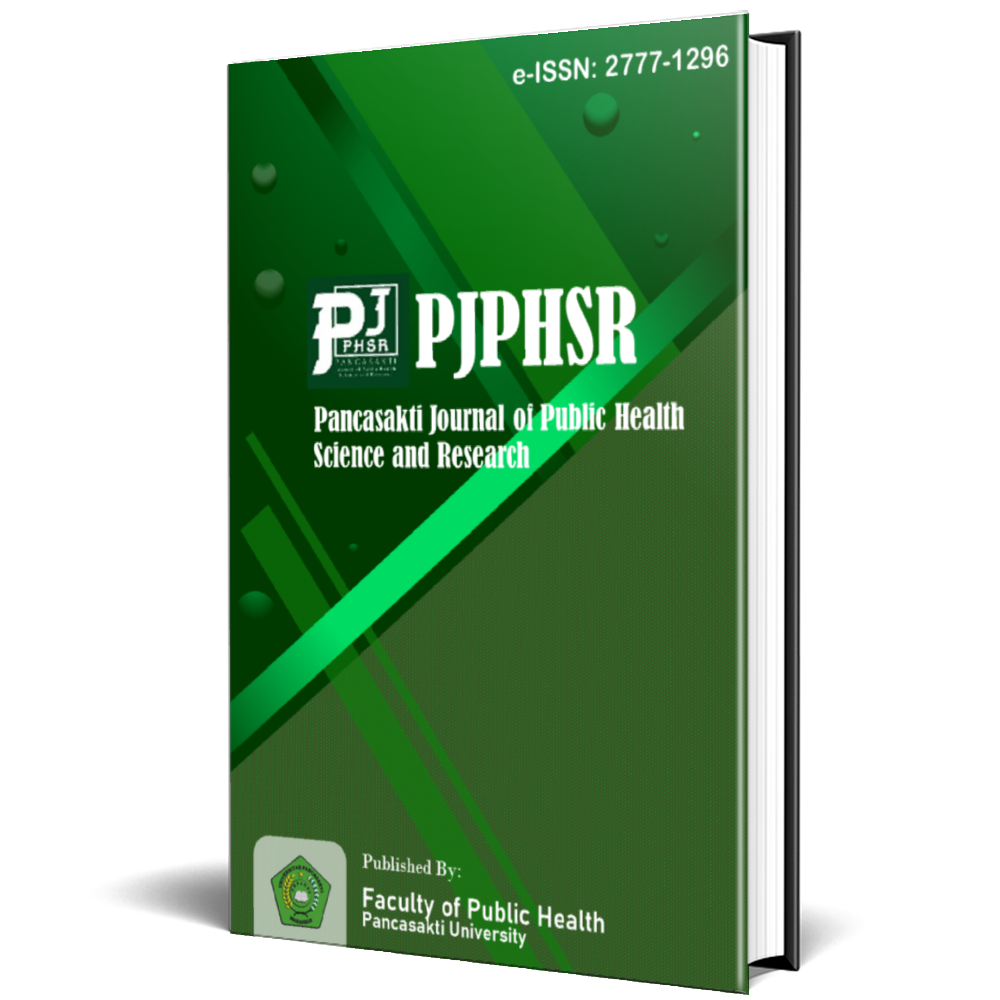Relationship between Physical Workload and Thermal Work Environment with Dehydration in Laundry Operators
Abstract
The production process at PT. K, a garment company in Malang, relies on manual equipment and human labor, exposing workers to physical strain and heat. Prolonged exposure to high temperatures can impair performance, accelerate fatigue, and increase the risk of dehydration. However, research on hydration status among laundry workers in the garment industry remains limited. This study aimed to examine the relationship between physical workload and the thermal work environment with hydration status among laundry workers at PT. K. This analytical cross-sectional study applied a total sampling method with 31 respondents. Data were analyzed using Spearman’s rank correlation test. Results showed no significant correlation between physical workload and hydration status (r = 0.302, p = 0.099), while a significant positive correlation was found between the thermal work environment and hydration status (r = 0.562, p = 0.001). In conclusion, thermal conditions were strongly associated with dehydration, whereas physical workload showed no significant relationship.
References
Athalia Putriwika Salsabila, Suroto, & Daru Lestantyo. (2023). Usia, Jenis Kerja, Pengetahuan, Iklim Kerja, dan Asupan Cairan Pada Kejadian Dehidrasi Pekerja Tambang. Jurnal Semesta Sehat (J-Mestahat), 3(2), 73–83. https://doi.org/10.58185/j-mestahat.v3i2.113
Dhareshwar, S., 2023. Dehydration. Elsevier eBooks, pp. 216–226. https://doi.org/10.1016/b978-0-12-821848-8.00027-5
Hakim, A. L., & Sulistyorini, L. (2021). Relationship of Environmental Physical Factors and Liquid Intake With Hydration Status of Lontong Home Industry Surabaya. Indonesian Journal of Public Health, 16(1), 79–88. https://doi.org/10.20473/ijph.v16i1.2021.79-88
Hess, H.W., Heikkinen, M.E., Tourula, E., Hite, M.J., Rivers, K., Johnson, B.D. dan Schlader, Z.J., 2025. Influence of work intensity on acute kidney injury risk and metabolic heat production. PMC, [online] Available at: https://pmc.ncbi.nlm.nih.gov/articles/PMC12199259/
Hua, Y., Chen, W., Wang, J., Zhou, Z., Luo, H. and Hu, H., 2023. Research and application of wet bulb globe temperature index in monitoring meteorological factors in high-temperature environments. Journal of Environmental and Occupational Medicine, 40(10), pp.1191–1196. https://doi.org/10.11836/JEOM23144
Ioannou, L. G., Foster, J., Morris, N. B., Piil, J. F., Havenith, G., Mekjavic, I. B., Kenny, G. P., Nybo, L., & Flouris, A. D. (2022). Occupational heat strain in outdoor workers: A comprehensive review and meta-analysis. Temperature, 9(1), 67–102. https://doi.org/10.1080/23328940.2022.2030634
Iriastadi, H., & Yassierli. 2017. Ergonomi Suatu Pengantar. Bandung: PT. Remaja Rosdakarya Offset.
Kementerian Kesehatan Republik Indonesia. (2016). Peraturan Menteri Kesehatan Republik Indonesia Nomor 70 Tahun 2016 tentang Standar dan Persyaratan Kesehatan Lingkungan Kerja Industri. Jakarta: Kementerian Kesehatan RI.
Srinivasan, K., Mohan, S., & Berlin Raj T, J. (2021). Occupational Heat Stress: A Technical Scan. Occupational Wellbeing, 1–11. https://doi.org/10.5772/intechopen.93900
Suryadi, I., Yuliadi, I., Rinawati, S., Rachmawati, S., & Nugraheni, B. (2020). The Relationship between Heat Stress and Physical Workload with Worker’s Hydration Status in Tirtonadi Bus Station Surakarta. E3S Web of Conferences, 202, 1–7. https://doi.org/10.1051/e3sconf/202020212018
Sutarto, T., Soemarko, D. S., & Ichsan, S. (2022). The Association between Heat Exposure and Hydration Status Among Production Workers in Fish Processing Company. The Indonesian Journal of Community and Occupational Medicine, 1(3), 146–153. https://doi.org/10.53773/ijcom.v1i3.33.146-53
Tarwaka. 2019. Ergonomi Industri Dasar- Dasar Pengetahuan Ergonomi dan Aplikasi di Tempat Kerja. Surakarta: Harapan Press
Tarwiyanti, D., Hartanti, R. I., & Indrayani, R. (2020). Beban Kerja Fisik dan Iklim Kerja dengan Status Hidrasi PekerjaUnit P2 Bagian (Wood Working 1) WW1 PT. KTI Probolinggo(Physical Workload and Work Climate Due to Workers HydrationStatus Unit P2 (Wood Working 1) WW1 Section PT. KTIProbolinggo ). E-Jurnal Pustaka Kesehatan, 8(1), 60–64.
Venugopal, V., Latha, P. K., Shanmugam, R., Krishnamoorthy, M., Srinivasan, K., Perumal, K., & Chinnadurai, J. S. (2020). Risk of kidney stone among workers exposed to high occupational heat stress - A case study from southern Indian steel industry. Science of the Total Environment, 722, 137619. https://doi.org/10.1016/j.scitotenv.2020.137619
Zulkarnain, M., Flora, R., Faisya, A. F., Martini, S., & Aguscik. (2020). Dehydration Index and Fatigue Level of Workers Laboring in Heat-Exposed Environments. 25(Sicph 2019), 164–168. https://doi.org/10.2991/ahsr.k.200612.022
Copyright (c) 2025 Reyna Sandrawati Cintya Dewi, Corie Indria Prasasti

This work is licensed under a Creative Commons Attribution-NonCommercial-ShareAlike 4.0 International License.








